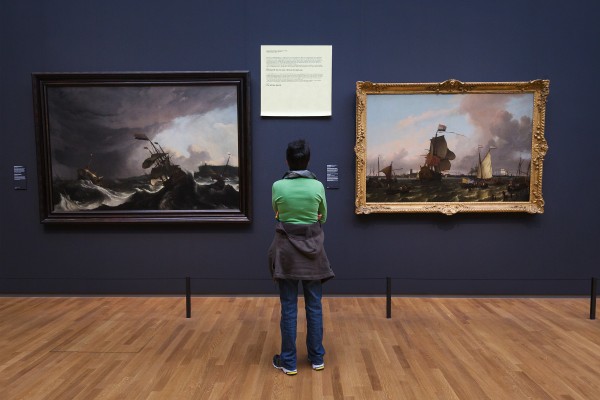Shotgun Reviews are an open forum where we invite the international art community to contribute timely, short-format responses to an exhibition or event. If you are interested in submitting a Shotgun Review, please click this link for more information. In this Shotgun Review, Christina Conklin reviews Art Is Therapy at the Rijksmuseum in Amsterdam.

Post-it note discussing two paintings; installation view, Art Is Therapy, 2014. Courtesy of the Rijksmuseum, Amsterdam. Photo: Olivier Middendorp.
Viewers are supposed to marvel at Rembrandt’s Night Watch (1642), but do they really? Many of us have unsatisfying responses to the works of the Masters, yet we still troop through the museums by the millions. This disconnect has led Alain de Botton and John Armstrong to guest-curate a selection of 150 works at the Rijksmuseum from their pragmatic point of view.
De Botton and Armstrong assert that art’s purpose is to heal some of the pain and malaise felt in life. It would be easy to dismiss this as didactic and anodyne. But reclaiming this broad, utilitarian view of art and reconnecting with the public in an approachable way is not simplistic. It is an important critical challenge to the reductive and self-referential intellectualism that dominates much contemporary discourse.
Tagging each work with large, yellow Post-it-style notes, the curators chat with the audience about the psychological dynamics of viewing art in a large museum. The notes aim to demystify the thoughts and feelings of viewers. Some notes describe the purpose of museums (“cathedrals of art”), while others name the alienation we feel in a room crowded with strangers. Democratizing the viewing experience in this way touches the soft underbelly of art, where contemporary critique has rejected notions of social purpose, beauty, and meaning and thus alienated much of the public.
Some of the texts hit the nail just right, opening up works in thoughtful ways, while others are a bit preachy or wordy, losing people halfway through. Paired with Pieter Jansz’s Interior of the Sint-Odulphuskerk in Assendelft (1649)—a small oil painting of a sermon being preached in a bare church bathed in light—is a note describing the artist’s intent to convey a “slightly stern, but welcome message: You have to fight off distraction, it can ruin your life.” Below, in larger text, a societal “Sickness” is diagnosed: “My life revolves around business, distraction, chaos, Twitter.” It became easy to simply read the sicknesses; a more careful crafting of the text and graphics, inverting the illness and cure, would have led to a clearer curatorial statement.
Much of the art in the Rijksmuseum’s collection was created to enlighten or heal the viewer, so it is an ideal environment in which to propose that art can and should address the communal and even spiritual aspects of life. De Botton and Armstrong developed a show that engages with a general audience of families, tourists, and other “art outsiders”; may it also instigate a dialogue within the art world toward a more integrated understanding of art.
Art Is Therapy is on view at the Rijksmuseum in Amsterdam through September 7, 2014.
Christina Conklin lives near San Francisco, where she recently completed her MFA at California College of the Arts. Her sculptural and installation work examines histories, rituals, and the scale of time.
Pieter Jansz. Interior of the Sint-Odulphuskerk in Assendelft, 1649; installation view, Art is Therapy, 2014. Courtesy of the Rijksmuseum, Amsterdam. Photo: Olivier Middendorp.
SOURCE: DAILY SERVING – Read entire story here.
Tags: rijksmuseum